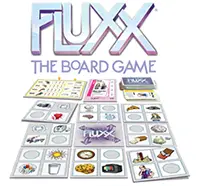
Fluxx is a game about change that changes as you play it - it's never the same game twice!
Just about everything in this game is in flux: the number of cards you draw and play each turn, how many times you move your pieces, and even the current arrangement of the ever-changing gameboard.
How do you win? That too is subject to change!
Components

- 9 x board tiles
- 2 x peg boards
- 100 x cards
- 12 x pieces
- 8 x pegs
- rules
How Is This Different From The Card Game?
For those who already know how to play Fluxx, here are the key changes and new things you'll need to know about. Obviously, there's now a gameboard, made up of tiles that will change positions as the game proceeds.
Players now control three pieces that they move around on the tiles, seeking to occupy the two spaces shown on the current goal. Instead of winning instantly by meeting the goal, you must now collect several goals, which you display in front of you (like keepers).
The deck contains four types of cards: goals (as just described), actions (which work as expected), leapers (which allow you to freely jump one of your pieces to the space depicted), and new rules cards.
Rules do not accumulate in a random pile as they do in the card game; instead, you discard them to move a peg on the rules pegboard. Every possible rules change has a peg, and almost everything else is subject to change - including the color of the pieces you control.
But while the number of goals you must collect to win can be altered during the game, no one can take away a goal that you've accomplished.
Object of the Game
To be the first person to collect the required number of goal cards.
Setup
Pegboards: Place a peg into each of the left-most positions for the seven rules on the rules pegboard. Then place a peg into the spot marked "3" on the win pegboard, or the "4" if you'd like a longer game.
Tiles: Place the start tile in the center of the table. Mix up the eight gameboard tiles and place them randomly around the start tile so that together the nine tiles form a big square.
Colors: Determine a color for each player. Place the color cards in front of each player, and place all three of their pieces on the start tile (leave unused colors in the box).
Goal Stack: Look through the deck for the first five goal cards you find and place them face up on the "Place Goals Here" space of the win pegboard. Players may look at all of the goals in this stack but after everyone has seen them, shuffle the cards so their order is randomized.
Cards: Shuffle the deck and deal out three cards to each player.
You Decide who goes first.
The first rule change is free
Before the game begins, everyone gets one free rule change of their choice. Going in turn order, each player chooses one of the pegs on either of the pegboards to move one notch to the right (or up if moving the win peg).
You can move any peg you want even if it's been moved before; however, you cannot reverse a previous player's move. All players must move a peg.
Game Play
On your turn, look at the rules pegboard and then do the following:
- Draw the number of cards indicated first.
- Play the number of cards indicated.
- Move the number of times indicated.
- Discard to the hand limit indicated last.
Note that you can play cards and make moves in any order, including alternating between the two.
Just make sure you keep careful track of how many moves you've made and how many cards you've played so that you perform the required numbers of each.
Exiting the start tile
Pieces can only be moved out of the start tile by following one of the four exit arrows. However, pieces can move (or be bumped) back onto the start tile from any space adjacent to the start tile.
Card Types

Action: Actions trigger interesting events. Just do whatever the card says, then place it on the discard pile. Everything that happens as a result of an action card (including use of other cards) is considered part of one "play".

New Rule: When these are played, the rules of the game are instantly changed. Shift the appropriate peg on the pegboard, place this card on the discard pile, and proceed.

Leaper: When you play a leaper, move one of your game pieces directly to the space shown on the card. If another piece is already there, that piece is moved back to the start tile, unless the space is an octagon or portal. Using a leaper card counts as a play, not as a move.

Goal: These cards establish objectives for the players to meet. Each goal depicts two spaces on the board, and the first player to position two of their pieces on the two spaces shown meets the goal.
They then take the goal card and keep it displayed in front of them until the game ends. To win, you will need to collect several goal cards.

Color: These cards are displayed in front of each player to remind everyone of what color they are using. Don't get too attached to your color - it may change during the game!
Moves
You may divide your moves between your pieces in any way you wish. For example, when the move setting on the rules pegboard is at three, one piece can move three spaces; three pieces can move one space each; or one piece can move one space and another piece can move two spaces.
No diagonal moves are allowed.
You must make all of the moves you can - no passing.
Special Spaces:

Octagons: These spaces have no occupancy limit. Any number of pieces can be placed on one octagon space at the same time.

Portals: Two tiles contain doorway spaces called portals. These spaces are connected by a magical secret passage. Whenever a piece moves onto a portal space (either by a move or by being bumped) it is instantly moved to the other portal.
This magical movement does not count as one of your moves; however, it does require one move to travel to the other portal if your piece starts out on a portal. Portals also have no occupany limit.
Move Example:
Let's look at a sample move. The red player moves a piece into a space occupied by a yellow piece, which causes the yellow piece to be bumped to another space. Where can the yellow piece be moved to?

Yellow cannot be bumped forward, since that space is also occupied, nor can it be bumped backwards into the space the red piece is vacating. The spaces in the other two directions are OK because one is empty and the other is an octagon, which isn't restricted.
Bumping
Spaces can hold only one piece at a time (with the exception of the octagons and portals). Consequently, in order to move into an occupied space you must bump the piece from that space to an adjacent space.
A piece may be bumped into any unoccupied adjacent space (or octagon or portal) except the space from which the current player moved. If this is not possible, then that game piece may not be moved.
This rule applies to the spaces through which the piece in play moves, not just the space where it lands. In other words, you may not pass through or jump over a piece that blocks your way.
You can bump your own pieces.
Hand Limit

The hand limit rule restricts the number of cards you can hold in your hand when it isn't your turn. When the peg is in its first position, there is no hand limit; otherwise, you must immediately discard all but the number of cards shown, unless it's your turn.
You can ignore the hand limit until your turn is over, but then you too must comply by discarding down to the indicated limit.
Special Moves
Depending on how the rules have been changed (as reflected on the rules pegboard) you may have the option to rotate a tile, uproot a tile, or to move your pieces wraparound-style.

Rotate: Rotating a tile uses one move. Any rotation amount (90, 180, or 270 degrees) is allowed.

Uproot: Picking up a tile and moving it to another spot (called "uprooting") also uses one move.
When you uproot a tile, you must preserve its orientation. To rotate a tile while uprooting, you must do each separately (assuming it's even allowable).
You cannot end your uproot action unless side-to-side connections exist between tiles such that every tile can be reached from the start tile. Here are some examples of legal and illegal tile placements:

Whenever rotating or uprooting a tile, take care to ensure that any pieces on the tile stay on their spaces.

Wraparound: When this option is on, pieces may move off one edge and reappear in the spot on the other side.
Leaping Gaps: If (and only if) the wraparound option is on, it is also permissible for pieces to leap over any gaps that have formed between tiles after uprooting.

Maxed Out Pegs
If a new rule card tells you to shift a peg forward, but the peg is already at the maximum setting, nothing happens.
However, if it says to choose between shifting it forwards or backwards, and only one is possible, you must make that change. You also must make the change anytime it says to toggle.
Adapting To Rule Changes
When you increase the number of cards drawn per turn, you draw an extra card to make up the difference. However, you don't have to give back cards you have already drawn if you lower the draw setting.
The same is true of plays and moves, in that you don't have to "take back" plays or moves that you have already taken, if those settings are lowered.
However, if you lower the play or move setting before you have taken all your plays or moves, you complete the remainder of your turn according to the new lower setting.
Collecting Goals
All goals require moving two of your pieces onto the pair of spaces shown on the card. Any time - including during other players' turns - that your pieces are in position to meet the requirements of the topmost goal on the stack, you take that card and keep it in front of you for the rest of the game.
When a new goal is played, it is added to the top of the stack on the pegboard. It is permissible to look through the stack (without changing the order of course) but only the goal on top is eligible for collection.
If you play a goal when you already have pieces on the required spaces, you can simply set the card down in front of you, rather than taking the formal step of placing it on the goal stack first and then collecting it.
If all the cards in the goal stack are gone, it simply remains empty until more goals are played.
End of the Game
To win, collect the number of goals currently shown on the win pegboard.
As soon as one player has the number of goals indicated, that player wins, unless two players achieve this at the same time, in which case the game continues until a single player has more goals than anyone else.
Continue Reading


